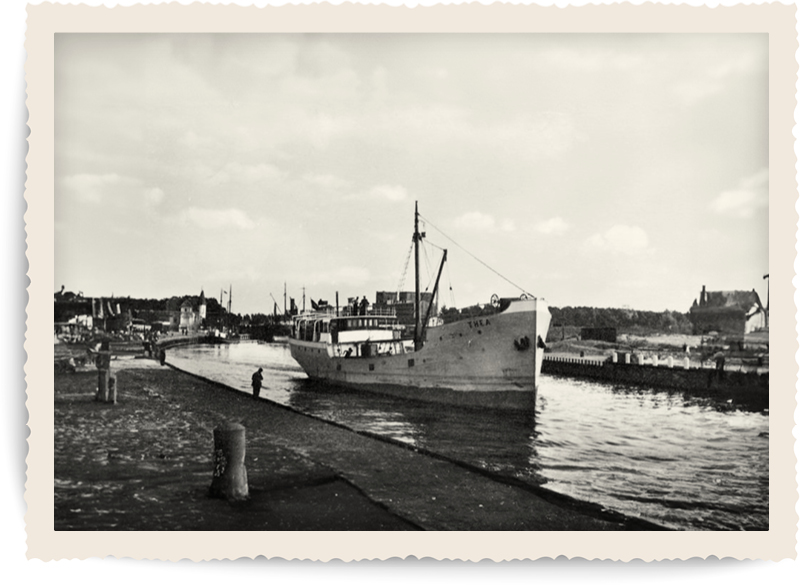
Captured merchant vessels, voyages to England, heroic deeds or sunk without trace… NNPC was founded shortly before the Second World War and so there’s a treasure trove of tales about the fleet that we insured at the time. What happened to “our” ships—where did they go and did they come back?
In this series of articles, we dive into the Dutch Merchant Shipping Database for 1940-1945 to find out what happened.
Aerial bombardments and torpedoes
In this third part, we will be looking at the vessels that succumbed to the rigours of war. Unfortunately, it was a significant risk during that period. German U-boats were lurking below the water’s surface, or the skies might suddenly start raining V1 rockets or Luftwaffe Messerschmitts. Severe losses were suffered and it was sometimes a question of all hands on deck to provide support for British naval vessels that had been hit. An important thing to keep in mind is that the crews of these ships were largely seamen from professional navigation, not trained naval marines.
Abel Tasman
We will start this grim list with the motorised freighter Abel Tasman. It fled the Netherlands in 1940 and was registered on May 16th with the Netherlands Shipping & Trading Committee in London. During Operation Dynamo, it managed to evacuate 220 stranded soldiers from Dunkirk. In June of that same year, though, the ship met an unfortunate end: after leaving Poole harbour, it hit a mine in the Swash channel and sank. None of its all-British crew survived the attack; the wreck was blown up in 1947.
Jutland
An accident with no fatalities: after fleeing from the Netherlands, the Jutland was placed under the English flag and used for rescuing allied troops from Dunkirk and Le Havre. After that, it reverted to the Dutch flag. On May 7th, 1943 it left Silloth in England with a cargo of coal destined for Fremington. Two days later, the cargo began to shift and the vessel capsized off Milford Haven. The Jutland didn’t sink but instead drifted along the coast and broke up on the rocks. The crew managed to get off the ship in time, though, and were then rescued.
Despatch
The coaster Despatch showed that a bit of damage doesn’t always lead to disaster. This vessel fled Ostend in Belgium in 1940 and was then immediately deployed for Dunkirk. During the return voyage on May 30th, with 263 French soldiers on board, the ship had engine problems. After six hours of frantic repairs, it managed to get safely to Ramsgate. The very next day, it set out again to bring another 165 people to safety! For the rest of the war, it was used for evacuations and finally also played a part in the Normandy landings on D-Day.
Pacific
The coaster Pacific from Groningen persevered heroically through no less than three major operations (Dynamo, Cycle and Neptune) before fate suddenly struck. On March 26th, 1945 the ship was underway in a convoy just outside Falmouth Bay in England when it was attacked in the early morning by a German U-boat. The submarine fired a torpedo at the Pacific that sadly was enough to sink it. Five crewmen were killed in the attack; five others were rescued. The British frigate HMS Duckworth counterattacked and was able to eliminate the U-boat using depth charges, killing most of the German sailors on it.
Wilhelmina
Sometimes we are just feeling our way in the dark because the historical sources are incomplete. Take the coaster Wilhelmina, which escaped in 1940 and got to England, where it was used as a freighter. On December 1st, 1941 the ship was involved in some kind of incident, but there are no further details. How serious was it? Was the ship lost or was it all much ado about nothing? The only other thing we know is that the captain, J. Vollers, was later decorated and awarded a Bronze Lion.
Thea
Last in this list is the Thea, which made the crossing to England in 1940 and went through some dangerous adventures there. The ship was moored in the Surrey Commercial Docks in London on September 7th, when a large-scale attack by German planes took place at about six o’clock. The Thea was next to two other Dutch coasters, the Antje and the Reiger. The crew weren’t on board, but thanks to major efforts from the neighbours, fires on and around the vessels were put out—partially successfully. In the end, the Thea was the only one that survived the attack; the other two ships were lost. This freighter didn’t get away unscathed, though: in the summer of 1944, it was hit by a German V1 rocket and badly damaged. Amazingly enough, they were able to repair the Thea after the war in the Netherlands.
Read the rest of the series “Our fleet during World War II” as well!
- Part 1 – Operations Dynamo and Neptune
- Part 2 – Seized by the Germans
- Part 3 – Ships that were badly damaged or sunk
- Part 4 – Food aid during the Hunger Winter





